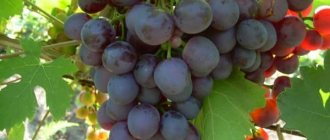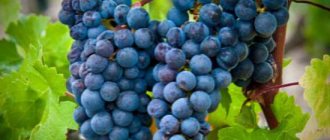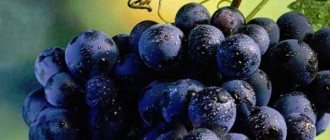Advantages and disadvantages
Just like any other crop, Merlot grapes have both advantages and disadvantages that you should be aware of when deciding to grow them.
The main advantages of Merlot include:
- Possibility of producing quality wine.
- Resistant to adverse weather conditions, pests and common diseases.
- Sugar accumulation is good for a technical grade.
- Consistently high yield.
- Quite a short ripening period.
In addition, “merlot” does not impose any special requirements on growing conditions and has a high rate of seedling survival.
Among the main disadvantages of the variety are:
- Tendency to pea berries.
- Low degree of resistance to fungal diseases and susceptibility to oidium.
- Dependence on weather conditions.
Also, despite the good frost resistance of the variety, it is necessary to cover it for the winter, especially when it comes to young plants.
Description of the variety
The first mentions of the Merlot grape variety (French blackbird) and wine made from its fruits date back to the end of the 18th century. - an official from the Bordeaux wine region described him in his notes.
Merlot's parents are Cabernet Franc and Madeleine Noir de Charentes.
The exact origin of the variety was unknown until 1992, when DNA analysis allowed scientists at the Davis Institute in California to determine the parental pair from which Merlot was bred. Its ancestors were the Cabernet Franc and Magdeleine noire des Charentes grape varieties.
Reference! Merlot grapes were included in the Russian state register in 2002.
Main characteristics
Merlot grapes have good characteristics in all directions. Proper care of the plant allows you to annually obtain consistently high yields: on average 45 c/ha - 80 c/ha.
Ripening period
The time of harvest depends on what kind of wine will be made from it. Thus, berries for dessert wines are harvested on the 165th day (beginning of October), grapes for table wine must be harvested at the end of September - on the 150th day.
Bush
Merlot grapes are a perennial plant, which is a large, vigorous bush with a highly branched root system, consisting of surface, lateral and main roots. The dark brown vine, covered with patchy, exfoliating bark, is characterized by moderate growth.
The leaves are medium-sized or large, three- or five-lobed, have a rounded shape and jagged edges, located oppositely. The leaf blades are wrinkled, slightly pubescent below, colored rich green, which in the fall changes to burgundy, yellow and scarlet.
In May-June, the flowering period begins and small, light green flowers appear on the plant, collected in paniculate inflorescences and emitting a delicate, pleasant aroma. Since the flowers are bisexual, there is a possibility of self-pollination, but more often this is done by insects.
bunches
The end of the growing season is characterized by the appearance on the bush of small, medium-dense or even loose clusters of cylindrical-conical shape, wider at the base and tapering towards the bottom. Some grapes have a side shoot (wing).
On average, the bunches reach 12-18 cm in length and 8-12 cm in width and weigh approximately 110-150 g, but with proper care and favorable weather conditions they can reach a weight of 200-250 g.
Berries
The fruits are round, weigh 1-2 g, covered with dense dark blue, almost black, skin with a good waxy coating.
The berries are juicy, the flesh is watery and dense. Inside are 1-3 small seeds of a light nut color. The pulp is dark, matching the peel, the juice is clear.
The fruits contain 18-20% sugar and 5-8.8 g/l acid.
Taste
The popularity of the Merlot grape is largely due to its harmonious and rich taste and aroma, which includes currants, cherries, blueberries, plums, caramel, chocolate, black and green peppers and herbs. Long-term aging of wine made from this variety in oak barrels contributes to an even greater opening of the palette of tastes and aromas, in which coffee notes and the taste of truffles begin to appear.
The taste of the fruit is affected by the soil on which the grapes grow. Thus, berries ripened on bushes grown in sandy soils have a milder taste, while limestone soils give the grapes a stronger and brighter aroma. You can learn about the ideal soil for grapes from a separate article.
Important! Eating berries in their pure form can lead to irritation of the mucous membranes and skin around the mouth.
How to drink Merlot wine
True connoisseurs of gastronomic wine taste know that all the notes and aromas of a drink can be fully revealed only by taking into account all the rules for its serving and consumption.
Interesting
This variety is distinguished by the absence of the need for many years of aging. It is preferable to drink it young, as it ripens quickly and reveals its light, pleasant taste.
Many tasters criticize Merlot for being monosyllabic and lacking a flavor ensemble. But there are also those lovers who appreciate precisely this softness and lightness of taste. Merlot does not have astringency and deep versatility, so it is loved by beginners, often young men or ladies who are getting acquainted with red wines. In addition, the ability to combine with different snacks plays in its favor.
Merlot should be drunk slightly chilled, at least 16 degrees. To begin with, enjoy the pleasant color of the drink through the transparent walls of the glass, appreciate the transparency and play of colors in the sun, and inhale the pleasant aroma of wine. Next, take a small sip to taste the bouquet and feel the delicate aftertaste. Merlot, like many other wines, should be drunk slowly, in small sips, enjoying the pleasant moment, the company and the surrounding atmosphere.
Accentuate the taste with a light dinner, choose snacks according to your taste, but do not overdo it with spicy, sour and salty dishes.
This drink can add some romantic or festive charm even to an ordinary dinner with the family. That's why it has become such a popular variety in France and beyond. Keep in mind that Merlot wines are quite strong, containing about 14 degrees of alcohol.
Comparison with analogues
Next, we compare “Merlot” with its main competitors, which also occupy one of the leading positions among technical varieties throughout the world.
| Sign | Variety | |||
| Merlot | Bianca | Pinot Noir | Saperavi | |
| Ripening period | 130-140 days | 110-120 days | 140 – 150 days | 150 – 160 days |
| Frost resistance | Up to -22 °C | Up to -27 °C | -30C | -23C |
| Productivity | 45-80 c/ha | Up to 20 kg. | 50 – 60 c/ha | 80 – 110 c/ha |
| Bunches | 200-250 g | 150-200 g. | 65 – 120 g | Up to 110 g |
| Taste | Harmonious | Almond flavor with honey and floral notes | Harmonious delicate taste | Harmonious with notes of freshness |
| Color | Dark blue | Yellow-green | Dark blue | Dark blue |
| Disease resistance | Average | High | Below average | Average |
| Shelf life | A few days | A few days | 3 – 4 months | 3 – 4 months |
| Sugar accumulation | 18-20% | 28% | 17 – 19% | 18 – 22% |
| Acidity | 5-8.8 g/l | 7 g/l | 7 – 8 g/l | 8 - 12 g/l |
Properties
Merlot grapes can be both beneficial and harmful. To understand what is more, consider its calorie content, sugar content and acidity.
Calorie content
The berries of this variety are not very high in calories. 100 g of fresh product contains 63 kcal. However, if the weather is warm for a long time, the berries can accumulate more sugar, which means their calorie content will be higher.
Benefits and harms
In general, grapes have beneficial effects on the human body, but they can also be harmful.
- There are quite a lot of useful properties:
- replenishing the body with vital vitamins (A, group B, C, K, H), macro- and microelements (potassium, magnesium, zinc, sodium), organic acids;
- general strengthening of the body;
- beneficial effect on the activity of the heart and vascular system;
- positive effect on kidney function;
- slowing down cell aging;
- calming the nervous system;
- getting rid of depression;
- maintaining the normal condition of the skin, hair and nails.
Berries can cause harm if a person has an intolerance to them and consumes them in excessive quantities. It should also not be used by allergy sufferers and diabetics.
Sugar content and acidity
The sugar content of the berries reaches 19.5–22%, acidity – 5.2–8.5%. In warm and dry years, the sugar content of grapes is higher.
Did you know? The most ancient winery known today was found by archaeologists on the territory of Armenia. It dates back to 4100–4000. BC e.
Features of cultivation
To obtain a high-quality and abundant harvest, it is necessary to monitor the correct cultivation of bushes and follow the rules of caring for them. It is also worth noting the importance of choosing the right planting site and suitable soil for the vineyard.
Trimming
There are 2 types of grape pruning, each of which serves a specific purpose:
- Sanitary – removal of damaged and diseased branches, carried out in the spring.
- Formative - pruning of old shoots to stimulate the growth of young shoots and increase yield, carried out in the fall. Basically, for this variety, medium or short bush formation is used.
One of the options for formative pruning
Reference! For better fruit set, you need to pinch the top.
Diseases and pests
The variety is classified as moderately resistant to diseases. Relatively resistant to mildew and fruit rot. Practically not resistant to such diseases:
| Disease | Description | Prevention |
| Oidium | A gray-silver or dirty white coating appears on the upper side of the leaves, which over time covers both sides of the leaf, fruits and shoots | When planting a plant, it is necessary to take into account the lighting and wind direction in the area, and orient the rows of bushes so that all bushes have equally good ventilation. It is necessary to regularly loosen the soil, and apply nitrogen and mineral fertilizers strictly following the instructions |
| Rubella | Red spots appear on the leaves | Regularly apply potassium-containing fertilizers, treat plants with a 1% solution of potassium nitrate |
| Bacteriosis | The shoots dry out, dark depressed spots appear on the leaves, fruits and stems | Before planting, cuttings should be kept in warm water, the plant should be treated promptly against pests, and only disinfected tools should be used for pruning. |
| Chlorosis | Leaves become lighter | It is important to plant the bushes correctly, add drainage to the bottom of the planting holes, regularly mulch and fertilize the soil |
| Anthracnose | Brown spots with dark edges form on the leaves | Spray the bushes with 1% Bordeaux mixture twice, with an interval of 2 weeks. |
Frost resistance
“Merlot” is dependent on weather conditions - not only late frosts, but also early heat can affect the quality and abundance of the harvest. At the same time, the grapes are quite productive in both arid and humid climates.
This variety tolerates frosts down to -20-22 °C, however, the construction of winter shelters is still recommended for adult plants and is mandatory for young bushes whose root system is not sufficiently developed.
Harvest storage duration
Due to their low density and low tannin content, Merlot grapes are not suitable for drying and long-term storage. Stored in a cool and ventilated area (cellar, refrigerator) for several weeks.
How to buy an original product
Unscrupulous producers have learned to counterfeit well-known wines, like other popular goods, and produce a low-quality product under the guise of an original one. As a result, an inexperienced buyer receives a low-grade counterfeit product at a high cost.
In order not to fall for the bait, all Merlot lovers need to know what kind of wine should be under this name, how to recognize a fake and determine its quality. To do this, just follow the following recommendations:
- Buy in specialized stores. At such points of sale, the chance of buying a counterfeit product is significantly reduced, because you will be provided with confirming quality certificates. In addition, they will be happy to help you choose a suitable drink if you are not well versed in wines.
- Pay attention to the color and transparency of the liquid. Real Merlot wines are characterized by the absence of any impurities or additives, so there should be no sediment or cloudiness in the bottle. The blends are also made from high quality clear ingredients.
- Inspect the bottle and packaging. A reliable manufacturer always makes sure that their product not only has excellent taste characteristics, but also high-quality packaging. It should not have any defects, including factory defects, chips, dents, unevenly applied labels, blurry inscriptions, etc.
- Check for the presence of a tax stamp. This element of protection must be present on products imported from abroad. The only exceptions are free trade zones.
Regions
The crop is grown in many countries of the world with a suitable climate: France, Italy, Spain, Portugal, Croatia, Montenegro, Algeria, USA and Chile. Every year, abundant harvests of Merlot are harvested by winegrowers in Ukraine and Moldova.
Reference! The variety is zoned for almost the entire territory of Russia, but it ripens best in the Krasnodar Territory.
Photo
Next, check out the photo of the Merlot variety.
Reviews
I live in Crimea and have been growing “merlot” and “saperavi” on my plot for many years. The wines from these varieties are excellent - tasty, aromatic, the merlot berries give the wine an incredible bouquet. I am glad that over the past year the sugar content of fruits has increased greatly. Gennady, Crimea
I’ve been making wine from Merlot for 2 years now – 2-3 buckets of berries are enough for almost 15 liters of wine. I have little experience in growing grapes and, frankly, I was worried about how it would grow, but I was nervous in vain - “Merlot” does not require any specific manipulations in care. Nikolay
What I like about this variety is that you can count on a harvest every year. But the disease resistance was a little disappointing - I thought that “merlot” would not get sick, but by the first autumn the leaves were infected with oidium, after which I began to treat the bushes prophylactically. Ivan
How to serve
True gourmets appreciate not only the bouquet of taste and aroma of wine, but also the presentation of the drink itself, because it is this that allows you to reveal the whole essence of the drink and enjoy it completely.
There are generally accepted rules for serving this alcoholic drink:
- Use tall, clear, round, thin stemmed wine glasses to allow you to fully see the color of the Merlot wine.
- The temperature of the drink when serving is very important. The ideal temperature is slightly below room temperature – 16-18 degrees. A wine that is overcooled will not fully reveal its flavor bouquet, and a wine that is too warm will prevent you from enjoying the aroma.
- After opening the bottle, leave the wine in the open decanter for a while; experts call this “letting the wine breathe.” At this stage, the drink supposedly opens up the taste, and also softens the tannin in the composition.
- Serve Merlot with the right appetizers: do not overuse dishes with spicy, salty, sour and bright flavors, otherwise the wine bouquet will be “lost” against such a background.











